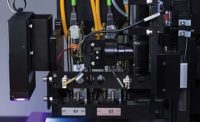With all the hype surrounding self-driving cars these days, steering wheels seem a bit archaic. Some experts claim the humble device will soon find itself alongside bench seats, carburetors, chrome bumpers, hubcaps and other relics of the past.
However, some of the most dynamic product development activity in the auto industry today involves steering wheels. That means the traditional driver-car interface could still be around for decades—just in some slightly different configurations.
“The steering wheel in some shape or form will prevail and will not disappear anytime soon,” says Christian Mueller, manager of European component forecasts and analysis at IHS Automotive. “During the transition to full autonomy, vehicles will feature steering wheels to enable manual control and ensure safety. However, they may be either retractable or inflatable devices that fold into the dashboard when not in use.”
One leading supplier, ZF TRW, envisions a retractable steering wheel that can significantly increase interior styling options and provide a customized environment for drivers. It would use a driver mode manager display located at the top of the steering wheel to choose between “A” for automated and “M” for manual.
In “automated” mode, the driver would fold the steering wheel away and create more space for carrying out other activities. Front-seat air bags would be housed above in the roof area.
Harman International Industries Inc. recently unveiled a shape-shifting steering wheel that can communicate directions to drivers through touch. As a turn approaches, the wheel swells on the corresponding side of the driver’s hand, with its thickness indicating how steep the upcoming turn will be. When it’s time to make the turn, the wheel begins to emit a pulse.
A few weeks ago, Ford Motor Co. announced that it will begin offering adaptive steering technology on several models of pickup trucks and sport utility vehicles. The automaker has received eight U.S. patents for the technology and 11 more have been filed.
“Despite the industry shift to electrically assisted steering, an overwhelming majority of new vehicles sold today have fixed steering gear ratios,” says Lodewijk Wijffels, adaptive steering technical specialist at Ford. “Fixed steering ratios are always a compromise between providing steering quickness and maneuverability at low speeds, while offering comfortable vehicle response at high speeds.”
The system—all contained in the steering wheel itself—features an electric motor, a small computer and a gear unit. Based on vehicle speed, adaptive steering can add or subtract rotations to driver input at the steering wheel. Up to one full revolution can be saved at low speeds when steering lock-to-lock.
"At low speeds, the system increases the angle of the front wheels as the steering wheel is turned, resulting in the driver needing to steer to steer less to maneuver," explains Wijffels. "At high speeds, the ratio is changed in such a way that vehicle response is more relaxed, more precise and smoother than without the system."
Earlier this year, engineers at Continental AG developed a gesture-based steering wheel that minimizes driver distraction.
“The new operating concept integrates seamlessly into the holistic human-machine interface and can replace other elements, such as buttons or even touch-sensitive surfaces on the steering wheel,” claims Ralf Lenninger, head of strategy, system development and innovation at Continental’s interior division.
The system uses two transparent plastic panels—without any electronic components—behind the steering wheel, which a driver can operate with his thumbs, almost like a touch pad.
“The clear design of the panels is compatible with almost any control geometry and new gestures can be added at any time,” says Lenninger. “In addition, the variable complexity ensures that the system can be integrated in many different vehicle classes and not just in the luxury segments.
“With gestures in a clearly defined area on the steering wheel, we can minimize distraction and increase safety,” explains Lenninger. “This narrowing down also prevents the driver from unintentionally starting gesture-based control by means of their usual everyday gestures, and thus making unwanted selections.”
A time-of-flight sensor detects hand motion and converts it into actions. A 3D camera equipped with an integrated 3D image sensor converts the infrared signal detected by the sensor into a 3D image. Driver hand positions and gestures are detected with millimeter precision.




